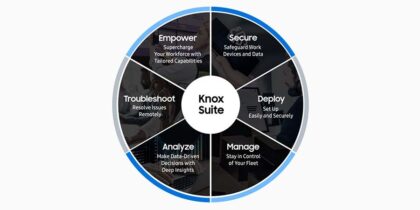The annual Gartner Security & Risk Management Summit unveiled the need for enterprise mobility management (EMM) and cybersecurity measures, spreading responsibility from the DevOps team all the way up to the boardroom. Mobile security and its array of capabilities were dissected by expert presenters, giving attendees a better understanding of the need for management solutions in a mobile-first environment.
The 2018 Gartner Symposium convened June 4-7 in National Harbor, Maryland, featuring a number of must-see sessions on capturing opportunity and mitigating risk in the Next Mobile Economy. In addition to emerging Gartner frameworks on integrated risk management and security management trends, several key themes and best practices for EMM emerged at the Symposium.
1. Security Is an Enabler
“Security doesn’t have to limit end-user experience,” stated Nick Rea, Vice President of Mobility Innovations at Samsung America, who presented at the event. “It can enable [positive] UX.” When discussing emerging themes at the Gartner Symposium, Rea pointed towards an increased focus among attendees on positioning “security as an enabler,” including a desire to obtain EMM tools that support agility in how products are securely deployed throughout the enterprise.
With solutions such as Knox Configure for mobility management, enterprises are able to strike the balance between security management and ease-of-use for external and internal stakeholders. Features enable organizations to quickly build and deploy purpose-built user experiences at scale.
2. Security Hygiene Practices Are Key
While sessions and content focused on emerging security trends and threats, there’s also a pointedly pragmatic trend among attendees in the industry — a desire to lock down security management and hygiene practices such as regular vulnerability patching. Rea said IT decision makers are increasingly aware “they need to get maintenance releases [on applications] out as soon as possible.”
Build a BYOD Plan for Your Business
Get our comprehensive guide and template for developing a BYOD policy tailored to your organization. Download Now
The majority of data breaches in the last two years were caused by unpatched software vulnerabilities, according to a Ponemon Institute study. Nearly 60 percent of organizations who suffered an incident were aware of the vulnerability. While surveyed organizations are struggling to hire additional security to keep up with patching requirements, the solution may lie in vendor partnerships and the cloud. The leading solution for EMM offers automated, monthly security updates to both the device operating system and the mobility software.
3. Risk Visibility Starts at the Device Level
“Compromise is inevitable,” says Jill Beadle of Gartner. Key security management projects for 2018 include “endpoint, network [and] user-based approaches for advanced threat detection, investigation and response capabilities.” While traditional perimeter-based solutions may protect against malicious third-parties, they neglect the insider risks and errors that account for up to 84 percent of data breaches, per ComputerWeekly.
The best method to protect against mobile-based insider risks may lie at the device level for total visibility into both device and user behavioral analytics, according to Rea. “Native capabilities are needed,” he said. “Samsung Knox is unique with a vertical, integrated supply chain.”
4. Compliance Is a Competitive Advantage
“Leading organizations are focused on how a compliance program can act as a business enabler,” says Gartner Research Vice President Peter Firstbrook. In an age where customer trust is at record lows, he urged security leaders to “communicate to CEOs that data protection has both costs and risk but can also be used as a business differentiator.” Balancing the expanding threat vector with increasingly costly compliance pressures requires EMM solutions engineered for defense-grade security.
5. BYOD Reaches Maturity
“The BYOD trend has matured,” acknowledged Rea. When asked how organizations are approaching EMM for BYOD and mixed environments, he stated the right solutions offer “as little complexity as possible and offer support for as many different platforms as possible.” In an age where the security talent shortage is reaching crisis levels, obtaining security management solutions that offer simplicity and the ability to manage risks at scale can support the organization’s ability to capture mobile opportunities and save costs.
This blog is part of a series of coverage of the Gartner Security & Risk Management Summit. Click here for insights on Resiliency for the Public Sector, Key Sessions from the Gartner Symposium, and Trends for the Financial Sector.







